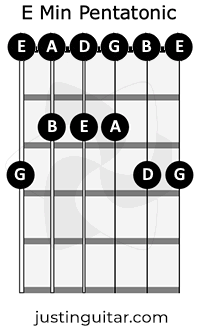Learn how to play the E Minor Pentatonic scale with valuable tips and visuals!
View the full lesson at Open E Minor Pentatonic Scale | JustinGuitar
Learn how to play the E Minor Pentatonic scale with valuable tips and visuals!
View the full lesson at Open E Minor Pentatonic Scale | JustinGuitar
Hard started at 60 on metro slow but getting better
Did this earlier at 70, need to keep at it
would you mind elaborating on why exactly this scale is important and the what it can be used for?
Welcome to the community Jarod. The minor pentatonic scale
is a movable scale and can be played in ever key.
It ca be used in Blues, Country, Rock, Metal and every other kind
of music you can think of. It is also the easiest scale to use to make
music.
If you’re into blues and rock, you will probably find you will use the minor pentatonic more than any other scale. However Justin does put more emphasis on the Major scale for reasons that will become aparrant.
In this lesson, not only is is relatively easy to play, it serves a purpose when learning Wish You Were Here. You won’t be expected to do much more with it for now but it is important as you will find.
Specifically for Open E minor, check out Link Wray Rumble, uses the Open E Minor Pentatonic walk down. Link Wray - Rumble [HQ - Best Version] - YouTube
Pretty fun beginner song too 
Pentatonic scales are the foundation/beginnings of (many) solos and rifts…
Memotechnic : 3 ; 3x2; 2x3 
Hi all,
Just curious. What exactly is a pentatonic scale?
A pentatonic scale is 5 note from the major parent scale.
The Major penatonic are the 1 2 3 5 6 intervals of the Major scale
The minor pentatonic scale are the 1 b3 4 5 b7 intervals of the Major scale.
For example the C Major scale consists of the notes
C D E F G A B. The interval for each note is 1 2 3 4 5 6 7.
Major pentatonic is C D E G A
Minor Pentatonic is C Eb F G Bb
Even after studying the note circle, it was helpful to me to draw the notes on the chord chart to visualize them. It helps solidify the shape, especially if you take into account the 1/2 step interval between B/C and E/F, which explains the larger jump on strings 1, 2 and 6 - this scale has no sharps or flats.

When you say “Memorize the scale shape” do you mean memorize/visualize the scale diagram or the scale tab that is in the notes?
The scale diagram. I.e. the actual shape, as it can be played anywhere on the neck. A tab is only good for one position on the neck.
and to add to @jacksprat …
Always make sure you know where the root note is in each scale pattern.
“ would you mind elaborating on why exactly this scale is important and the what it can be used for?”
@jaordd Once you play the E minor pentatonic scale a few times and learn the stuck 3,4 Em7 chord you are halfway to learning the intro riff to Wish You Were Here by Pink Floyd which you will learn in this module.
@DavidP Is the root note of the Emin Pentatonic scale E? Does that mean the root would be the first note in the scale?
@Sound_Bound yes the root note is E. If you play the scale using all 6 strings it appears 3 time. On both E strings and the D string 2nd fret.
Thank you @stitch. It’s just occurred to me that root is meaning the underlying sound across the whole scale rather than just the lowest note.
It feels so weird to play a scale with mostly open strings, no place to anchor fingers. I can play both G and further down the neckminor and major pentatonics at around 80 bpm (and maybe even faster but above 80 it is all speed no thought of timing) but somehow the fact that there’s so many open stings makes it hard to anchor on that one.
I don’t understand why is this played with fingers 2 and 3 and not with fingers 3 and 4? Because as soon as we play this shape in any non-open position on the fretboard, we have to use finger 1 to “replace” the nut and then for other notes we have to use fingers 3 and 4 anyway. So why bother to learn different fingering in the open position?